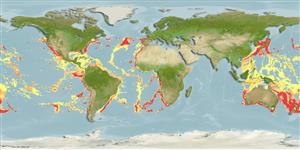Teleostei (teleosts) >
Anguilliformes (Eels and morays) >
Synaphobranchidae (Cutthroat eels) > Simenchelyinae
Etymology: Simenchelys: Greek, simo = flattening + Greek, enchelys, -yos = eel (Ref. 45335).
More on author: Gill.
Environment: milieu / climate zone / depth range / distribution range
Ecology
Marine; bathydemersal; depth range 100 - 3000 m (Ref. 117245), usually 500 - 1800 m (Ref. 58302). Deep-water; 4°C - 9°C (Ref. 26895); 45°N - 45°S, 110°E - 23°E
Eastern Atlantic: France to Madeira and the Azores, one specimen near Cape Verde, also off South Africa. Western Atlantic: USA. Western Pacific: off Japan, near Wake Island, Australia (Ref. 7300) and off New Zealand.
Length at first maturity / Size / Weight / Age
Maturity: Lm ?, range 45 - ? cm
Max length : 61.0 cm TL male/unsexed; (Ref. 559)
Grey to greyish brown in color, darker on fin edges and along lateral line (Ref. 3973). Body with scales in grouped, right-angle basketweave pattern. Thick head, blunt, cylindrical. Small mouth, gape falling well short of the orbit; strongly plicate lips around the slit-like mouth; hyomandibula canted anteriorly. Broadly separate gill slits. Reduced cephalic lateralis system (Ref. 26895).
Found on the continental slope and upper abyssal depths. Feed on invertebrates (epibenthic copepods and amphipods) and fishes (Ref. 6726). Reported to be parasitic on fishes. Eggs are probably pelagic (Ref. 6726).
Life cycle and mating behavior
Maturities | Reproduction | Spawnings | Egg(s) | Fecundities | Larvae
Sulak, K.J. and Y.N. Shcherbachev, 1997. Zoogeography and systematics of six deep-living genera of synaphobranchid eels, with a key to taxa and description of two new species of Ilyophis. Bull. Mar. Sci. 60(3):1158-1194. (Ref. 26895)
IUCN Red List Status (Ref. 130435)
Threat to humans
Harmless
Human uses
Fisheries: of no interest
Tools
Special reports
Download XML
Internet sources
Estimates based on models
Preferred temperature (Ref.
123201): 2.4 - 9.5, mean 4.2 °C (based on 1993 cells).
Phylogenetic diversity index (Ref.
82804): PD
50 = 1.0000 [Uniqueness, from 0.5 = low to 2.0 = high].
Bayesian length-weight: a=0.00145 (0.00057 - 0.00366), b=3.01 (2.79 - 3.23), in cm total length, based on LWR estimates for this (Sub)family-body shape (Ref.
93245).
Trophic level (Ref.
69278): 3.7 ±0.54 se; based on food items.
Resilience (Ref.
120179): Medium, minimum population doubling time 1.4 - 4.4 years (Assuming fecundity > 100).
Fishing Vulnerability (Ref.
59153): Moderate vulnerability (44 of 100).
Nutrients (Ref.
124155): Calcium = 8.42 [2.49, 28.96] mg/100g; Iron = 0.359 [0.119, 0.939] mg/100g; Protein = 17.5 [15.3, 19.9] %; Omega3 = 0.334 [0.136, 0.888] g/100g; Selenium = 25.7 [7.6, 83.9] μg/100g; VitaminA = 4.94 [0.96, 24.96] μg/100g; Zinc = 0.28 [0.14, 0.55] mg/100g (wet weight);
